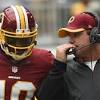3 Keys: United States vs. Canada, 4 Nations Face-Off

Here are 3 keys to the game:
1. Identity checks
The Canadians played more of a skill game against Sweden led by Crosby. That plays to more of their identity.
The Americans played more of a physical, banging type of game against Finland, led by the Tkachuk brothers. That style plays more to their identity.
But Canada knows it's going to be a heavier game against the United States, which is likely why Sam Bennett is entering the lineup, replacing Travis Konecny, to center a line that will also feature Brad Marchand and Seth Jarvis.
That line could be an answer to the Tkachuk brothers and Jack Eichel. Brady and Matthew Tkachuk, Bennett's teammate with the Florida Panthers, were moved to Eichel's wings in the second period against Finland and they dominated.
Brady and Matthew each had two goals, combining for three in the third period. Eichel had two assists.
"It'll be interesting if Sam and Matthew meet in a corner," Canada coach Jon Cooper said.
2. Goaltending
Canada is sticking with Jordan Binnington, who made 23 saves in the win against Sweden. However, he gave up two goals on 10 shots in the third period, allowing the Swedes to come back from 3-1 down to force overtime.
He likely will have to be better than he was against Sweden for Canada to defeat the U.S.
The U.S., unsurprisingly, is sticking with Connor Hellebuyck, who gave up a goal to Henri Jokiharju on the second shot he faced 7:31 into the first period against Finland, but stopped the next 19 shots in the 6-1 win.
Hellebuyck undoubtedly will be tested more by Canada than he was Finland.
3. Finding balance between physicality and discipline
The one thing the Americans know they cannot do, especially early in the game, is allow their physicality to get the better of them, putting the Canadians on the power play.
They want to be fast and aggressive, but Sweden found out the hard way what giving Canada a power play early in the game can do.
It took 12 seconds for a power play featuring Crosby, McDavid, Nathan MacKinnon, Sam Reinhart and Makar to strike. McDavid to Crosby to Mackinnon and into the back of the net.
"It's a controlled aggression," McAvoy said. "You don't want to just be running around and putting yourself out of position. When it's there it's there, and you'll know when to take it. We want to be playing hard. As a [defense] corps, we want to be playing physical and hard and trying to limit time and space as much as we can.
"It's like playoff hockey. That's probably the best thing I can compare it to when you're just trying to tow that line in a pivotal game in the playoffs. You know you can't cross it, take a penalty and put your team in a tough spot. You have to read the game, and that's what we'll do."


 United States
United States Argentina
Argentina  Australia
Australia  Austria
Austria  Brazil
Brazil  Canada
Canada  Chile
Chile  Czechia
Czechia  France
France  Germany
Germany  Greece
Greece  Italy
Italy  Mexico
Mexico  New Zealand
New Zealand  Nigeria
Nigeria  Norway
Norway  Poland
Poland  Portugal
Portugal  Sweden
Sweden  Switzerland
Switzerland  United Kingdom
United Kingdom 



































